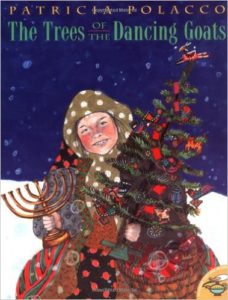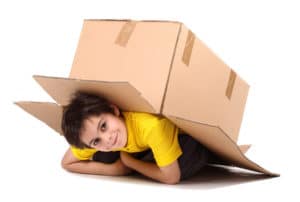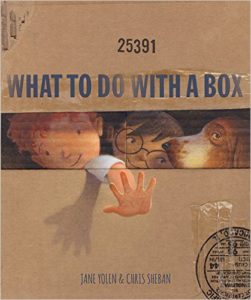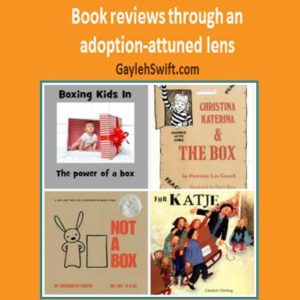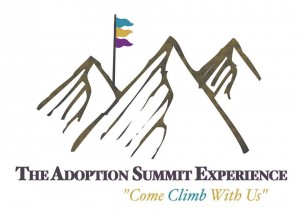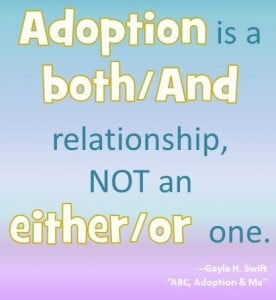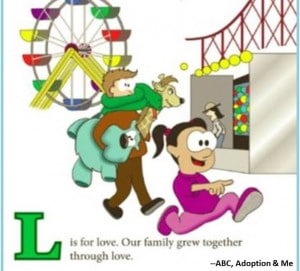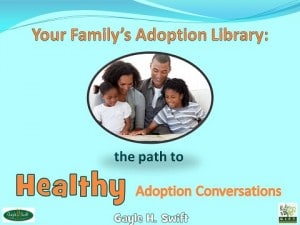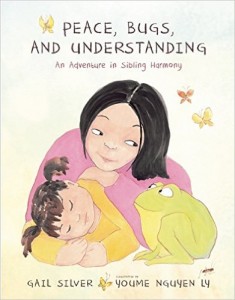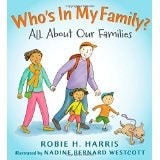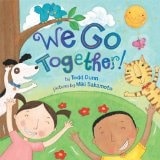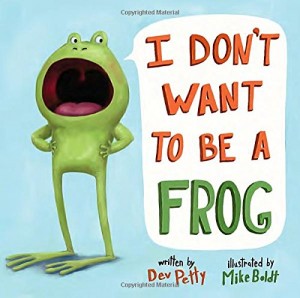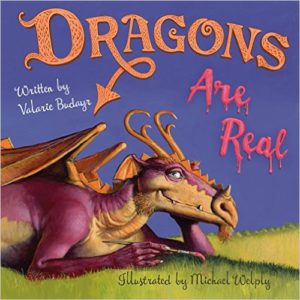 Dragons and dinosaurs fascinate children so they’re predisposed to love Dragons Are Real by Valerie Budayr and illustrated by Michael Welply. It delivers the full inside story on the fire-breathing beasts. Who knew dragons need friends and yearn to be a child’s BFF? Or that they crave sweets as much as any kid dreaming of Halloween? All those stories of treasure hoarding paint the wrong picture of the draco species. It’s just that sparkling things dazzle and things catch a dragon’s attention. In actuality, it’s not jewels they crave and hoard. It’s books. Lots and lots and lots of books.
Dragons and dinosaurs fascinate children so they’re predisposed to love Dragons Are Real by Valerie Budayr and illustrated by Michael Welply. It delivers the full inside story on the fire-breathing beasts. Who knew dragons need friends and yearn to be a child’s BFF? Or that they crave sweets as much as any kid dreaming of Halloween? All those stories of treasure hoarding paint the wrong picture of the draco species. It’s just that sparkling things dazzle and things catch a dragon’s attention. In actuality, it’s not jewels they crave and hoard. It’s books. Lots and lots and lots of books.
My favorite newly discovered dragon-fact: they love to read. We’re kindred spirits! I’ve taken the liberty of naming this special dragon: Draco Bibliophilium which loosely translates from the Latin as “Book Loving Dragon.”) He’s near and dear to my heart because I love books too. (Anyone who has visited my office would know. In fact, it looks like the illustrator used my office for an illustration study.)
Dragons Are Real seeks to clear up many misperceptions that identify dragons as evil, dangerous and, scary. The very idea that dragons yearn to capture hapless maidens is preposterous; they’re simply trying to be helpful and make a friend in the process. Now it is true that dragons breathe fire, but only when they want to be useful like toasting hot dogs or making s’mores. It can be very handy to have a friend with a built-in fuel source and an inclination to help out when needed. Turns out, that dragons are loyal and funny. Apparently they love poetry to an excess which can be a bit tedious. But don’t we all have our quirks and faults?
This story transforms a traditional “monster” figure from children’s folklore into a charming and desirable pal, one who loves to laugh and dance and recite poetry. I love that! By turning the myth upside down, which offers young readers a model for looking at the “monsters” in their own personal lives to reinterpret them in a way which enables them to cope. Since dragons are masters of camouflage, they can be “hiding in plain sight.” This concept can easily lead to discussions about how we can overlook people as well as how we choose to hide ourselves and be small. These are big ideas, but understanding them can help kids notice whom they might be overlooking and or how they themselves might be fading into the background. It also invites readers to think about what it is like to need a friend, how to be a friend as well as how to find a friend. All of these are important skills.
The ability to blend in and be part of a bigger picture can be useful. Sometimes, we even want to blend in so well that we become invisible so we can sit back, observe and determine what we want to do. Dragons Are Real makes an import point: We must embrace our “fire.” Allow it to burn brightly so we can be “seen” and cast a light for others to follow.
The illustrations are amazing and vividly interpret the text. The pictures are an adventure in their own right and compliment the text well. They add the perfect measure of whimsy, humor and ferocity.
 Adoption-attuned Lens: It is common for adoptees to spend considerable time thinking about big “what ifs.” (What if I hadn’t been adopted? What if I’d been adopted by someone else? What if my adoptive parents rejects me? And many more.) Many develop chameleon-like skill at blending in and becoming what they think others expect them to be–or do. Adoptees who don’t share a culture or race with their adoptive family may struggle to fit in ad feel “at home” in their adoptive family. [bctt tweet=”Like the proverbial dragon striving to remake his fierce image, adoptees must learn how to blend their dual heritage into a cohesive whole.” username=”GayleHSwift”] The key is to fit in without losing their authentic selves, like a dragon who breathes fire but learns not to burn down the neighborhood!
Adoption-attuned Lens: It is common for adoptees to spend considerable time thinking about big “what ifs.” (What if I hadn’t been adopted? What if I’d been adopted by someone else? What if my adoptive parents rejects me? And many more.) Many develop chameleon-like skill at blending in and becoming what they think others expect them to be–or do. Adoptees who don’t share a culture or race with their adoptive family may struggle to fit in ad feel “at home” in their adoptive family. [bctt tweet=”Like the proverbial dragon striving to remake his fierce image, adoptees must learn how to blend their dual heritage into a cohesive whole.” username=”GayleHSwift”] The key is to fit in without losing their authentic selves, like a dragon who breathes fire but learns not to burn down the neighborhood!
Fun activity
Ask your child to create a dragon from his imagination. Draw it. Paint it. Build it from Legos©, clay or from materials found in your recycle bin. Then give it a name. For an added challenge, try to include a Latin variation as Valerie did. (J. K. Rowling also included Latin phrases in her beloved Harry Potter series; it sounds ever so mysterious and magical! I’m sure parents and Google, Siri, etc. can provide any needed assistance.) Encourage your child to write his/her dragon’s story; you just might be awakening a dormant talent.
Multicultural Children’s Book Day 2017 (1/27/17)
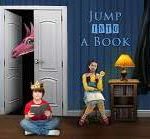
is in its fourth year and was founded by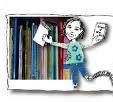
Valarie Budayr from Jump Into A Book
and Mia Wenjen from PragmaticMom.
Our mission is to raise awareness on the ongoing need to include kid’s books that celebrate diversity in home and school bookshelves while also working diligently to get more of these types of books into the hands of young readers, parents and educators.
Despite census data that shows 37% of the US population consists of people of color, only 10% of children’s books published have diversity content. Using the Multicultural Children’s Book Day holiday, the MCBD Team are on a mission to change all of that.
Current Sponsors: MCBD 2017 is honored to have some amazing Sponsors on board. Platinum Sponsors include Scholastic, Barefoot Books and Broccoli. Other Medallion Level Sponsors include heavy-hitters like Author Carole P. Roman, Audrey Press, Candlewick Press, Fathers Incorporated, KidLitTV, Capstone Young Readers, ChildsPlayUsa, Author Gayle Swift, Wisdom Tales Press, Lee& Low Books, The Pack-n-Go Girls, Live Oak Media, Author Charlotte Riggle, Chronicle Books and Pomelo Books
Author Sponsor include: Karen Leggett Abouraya, Veronica Appleton, Susan Bernardo, Kathleen Burkinshaw, Maria Dismondy, D.G. Driver, Geoff Griffin, Savannah Hendricks, Stephen Hodges, Carmen Bernier-Grand,Vahid Imani, Gwen Jackson, Hena, Kahn, David Kelly, Mariana Llanos, Natasha Moulton-Levy, Teddy O’Malley, Stacy McAnulty, Cerece Murphy, Miranda Paul, Annette Pimentel, Greg Ransom, Sandra Richards, Elsa Takaoka, Graciela Tiscareño-Sato, Sarah Stevenson, Monica Mathis-Stowe SmartChoiceNation, Andrea Y. Wang
We’d like to also give a shout-out to MCBD’s impressive CoHost Team who not only hosts the book review link-up on celebration day, but who also work tirelessly to spread the word of this event. View our CoHosts HERE. Valerie and Mia
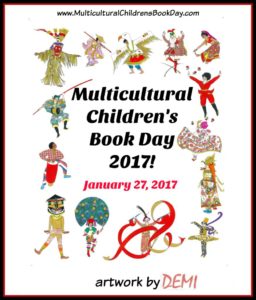 MCBD Links to remember: MCBD site
MCBD Links to remember: MCBD site
Free Multicultural Books for Teachers
Free Kindness Classroom Kit for Homeschoolers, Organizations, Librarians and Educators
Free Diversity Book Lists and Activities for Teachers and Parents:
Hashtag: Don’t forget to connect with us on social media and be sure and look for/use the official hashtag #ReadYourWorld.
You can make a difference. [bctt tweet=”Be a driving force for #Diversity in publishing. ” username=”GayleHSwift”] Help ensure that we have a robust range of “windows” and “mirrors” so that all children can see themselves in their literature as well as introduce them to a broad array of cultures. Exposure grows familiarity which in turn, nurtures understanding and tolerance.
[bctt tweet=”#BuyDiversity #ReadDiversity #WriteDiversity” ” username=”GayleHSwift”]
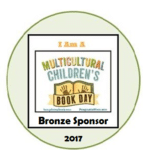
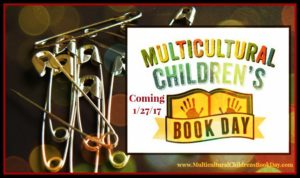
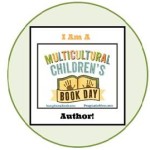
 Diane Alber wrote and illustrated Snippets: A Story about Paper Shapes. It is a clever, charming book which at first glance appears to be about having fun with arts and crafts materials. If one pauses to read the Dedication, however, the reader learns that the book has a far more important purpose: “You can change the world one snippet of kindness at a time.” Spreading kindness is a worthy purpose indeed and children benefit from understanding how they can bring kindness to life in their daily lives.
Diane Alber wrote and illustrated Snippets: A Story about Paper Shapes. It is a clever, charming book which at first glance appears to be about having fun with arts and crafts materials. If one pauses to read the Dedication, however, the reader learns that the book has a far more important purpose: “You can change the world one snippet of kindness at a time.” Spreading kindness is a worthy purpose indeed and children benefit from understanding how they can bring kindness to life in their daily lives. AQ Lens: Adopted children frequently encounter rude comments that focus on adoption, for example: Why did your mom not want you? What was wrong with you? Why don’t you look like your family? Needless to say, these are painful moments for children. A book like this offers a way that parents can open conversations and provide insight and support that address the hurt and worry so that kids don’t struggle to shoulder it by themselves.
AQ Lens: Adopted children frequently encounter rude comments that focus on adoption, for example: Why did your mom not want you? What was wrong with you? Why don’t you look like your family? Needless to say, these are painful moments for children. A book like this offers a way that parents can open conversations and provide insight and support that address the hurt and worry so that kids don’t struggle to shoulder it by themselves.

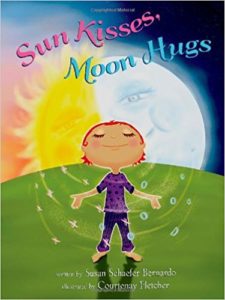




 MCBD Links to remember:
MCBD Links to remember: 


